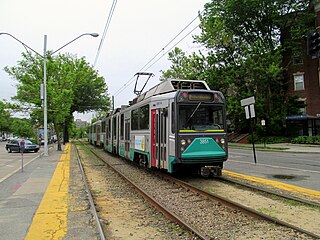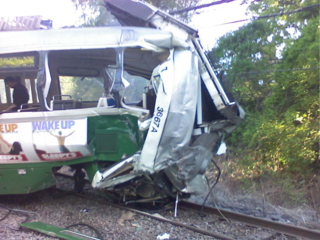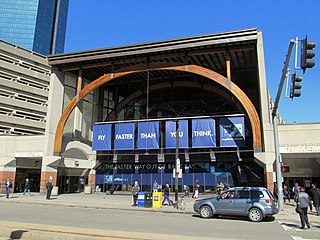
The Green Line is a semi-metro system run by the Massachusetts Bay Transportation Authority (MBTA) in the Boston, Massachusetts, metropolitan area. It is the oldest MBTA subway line, and with tunnel sections dating from 1897, the oldest subway in North America. It runs underground through downtown Boston, and on the surface into inner suburbs via six branches on radial boulevards and grade-separated alignments. With an average daily weekday ridership of 137,700 in 2019, it is the third most heavily used light rail system in the country. The line was assigned the green color in 1967 during a systemwide rebranding because several branches pass through sections of the Emerald Necklace of Boston.

On March 15, 1999, Amtrak's southbound City of New Orleans passenger train collided with a semi-trailer truck in the village of Bourbonnais, Illinois, United States. Most of the train derailed, killing eleven people. A National Transportation Safety Board (NTSB) investigation into the accident attributed the cause to the truck driver trying to beat the train across a grade crossing. The NTSB's recommendations from the accident included increased enforcement of grade crossing signals, the installation of train event recorders at all new or improved grade crossings, and procedures to provide emergency responders with accurate lists of all crew members and passengers aboard trains. The city of Bourbonnais erected a memorial near the site to commemorate those killed in the accident.
The Federal Express was an overnight named passenger train run by the Pennsylvania Railroad and the New York, New Haven and Hartford Railroad between Washington, DC's Union Station and Boston, Massachusetts's South Station from 1912 to 1971. At different times, its route has taken it across the Hudson River via a car float between Port Morris and Jersey City, the Poughkeepsie Bridge, and finally the Pennsylvania Tunnel and Terminal Railroad. The final routing was identical to today's high-speed Northeast Corridor.

On January 4, 1987, two trains collided on Amtrak's Northeast Corridor main line near Chase, Maryland, United States, at Gunpow Interlocking. Amtrak train 94, the Colonial, traveling north from Washington, D.C., to Boston, crashed at over 100 miles per hour (160 km/h) into a set of Conrail locomotives running light which had fouled (entered) the mainline. Fourteen passengers on the Amtrak train died, as well as the Amtrak engineer and lounge car attendant.

The San Bernardino train disaster, was a combination of two separate but related incidents that occurred in San Bernardino, California, United States: a runaway train derailment on May 12, 1989; and the subsequent failure on May 25, 1989, of the Calnev Pipeline, a petroleum pipeline adjacent to the tracks which was damaged by earth-moving equipment during the crash cleanup.

The Providence/Stoughton Line is an MBTA Commuter Rail service in Massachusetts and Rhode Island, primarily serving the southwestern suburbs of Boston. Most service runs entirely on the Northeast Corridor between South Station in Boston and Providence station or Wickford Junction station in Rhode Island, while the Stoughton Branch splits at Canton Junction and terminates at Stoughton. It is the longest MBTA Commuter Rail line, and the only one that operates outside Massachusetts. The line is the busiest on the MBTA Commuter Rail system, with 17,648 daily boardings in an October 2022 count.

On May 28, 2008, shortly before 6:00 p.m., two westbound MBTA trains collided on the Green Line D branch between Woodland and Waban stations, behind 56 Dorset Road in Newton, Massachusetts. An investigation by the National Transportation Safety Board (NTSB) originally found the cause of the accident to be due to the operator texting while driving, but the NTSB later found that the operator of the rear train, Terrese Edmonds, had not been using her cell phone at the time of the crash, but rather went into an episode of micro-sleep, causing her to lose awareness of her surroundings and miss potential hazards up ahead. The collision killed Edmonds, and numerous others were injured. Fourteen passengers were taken to area hospitals; one was airlifted. This crash, along with another similar accident a year later, led the NTSB to set higher standards and regulations regarding the use of cell phones while operating a train.

The 2008 Chatsworth train collision occurred at 4:22:23 p.m. PDT on September 12, 2008, when a Union Pacific freight train and a Metrolink commuter train collided head-on in the Chatsworth neighborhood of Los Angeles, California, United States.

Back Bay station is an intermodal passenger station in Boston, Massachusetts. It is located just south of Copley Square in Boston's Back Bay and South End neighborhoods. It serves MBTA Commuter Rail and MBTA subway routes, and also serves as a secondary Amtrak intercity rail station for Boston. The present building, designed by Kallmann McKinnell & Wood, opened in 1987. It replaced the New Haven Railroad's older Back Bay station – which opened in 1928 as a replacement for an 1899-built station – as well as the New York Central's Huntington Avenue and Trinity Place stations which had been demolished in 1964.

On February 16, 1996, a MARC commuter train collided with Amtrak's Capitol Limited passenger train in Silver Spring, Maryland, United States, killing three crew and eight passengers on the MARC train; a further eleven passengers on the same train and fifteen passengers and crew on the Capitol Limited were injured. Total damage was estimated at $7.5 million.

The Fairfield/Bridgeport train crash occurred on May 17, 2013, when a Metro-North Railroad passenger train derailed between the Fairfield Metro and Bridgeport stations in Fairfield, Connecticut, in the United States. The derailed train fouled the adjacent line and a train heading in the opposite direction then collided with it. There were at least 65 injured among the approximately 250 people on board each of the two trains. Metro-North reported damages at $18.5 million.

On the morning of December 1, 2013, a Metro-North Railroad Hudson Line passenger train derailed near the Spuyten Duyvil station in the New York City borough of the Bronx. Four of the 115 passengers were killed and another 61 injured; the accident caused $9 million worth of damage. It was the deadliest train accident within New York City since a 1991 subway derailment in Manhattan, and the first accident in Metro-North's history to result in passenger fatalities. The additional $60 million in legal claims paid out as of 2020 have also made it the costliest accident in Metro-North's history.
The Night Owl was a passenger train operated by Amtrak on the Northeast Corridor between Washington, D.C., and Boston, Massachusetts, via New York City. It operated from 1972 to 1995 on an overnight schedule with sleeper service; it was the only such train on the Northeast Corridor. In 1995 Amtrak dropped most individual train names from its Northeast Corridor services and the Night Owl became another NortheastDirect service, but still on an overnight schedule. Amtrak replaced it with the Twilight Shoreliner in 1997.

The 2015 Oxnard train derailment occurred on February 24, 2015, at 5:44 a.m. local time when a Metrolink passenger train collided with a truck that a driver had mistakenly turned from Rice Avenue onto the tracks and became stuck. After impact, the train derailed at Oxnard, California, United States. As a result of the crash, the train engineer died from his injuries a week later and 32 passengers and crew members were injured. The truck driver exited his vehicle and ran from the scene prior to the crash; he sustained minor injuries that were unrelated to the crash sequence.

On April 3, 2016, Amtrak train 89, the southbound Palmetto, struck a backhoe while travelling through Chester, Pennsylvania, killing two track workers and derailing the locomotive, as well as damaging the first two cars.

On December 18, 2017, Amtrak Cascades passenger train 501 derailed near DuPont, Washington, United States. The National Transportation Safety Board's (NTSB) final report said regional transit authority Sound Transit failed to take steps to mitigate a curve at the accident location, and inadequately trained the train engineer. The train was making the inaugural run of the Point Defiance Bypass, a new passenger rail route south of Tacoma, Washington, operated by Amtrak in partnership with state and local authorities in Oregon and Washington, on right-of-way owned and operated by Sound Transit. The bypass was intended to reduce congestion and separate passenger and freight traffic, and was designed for faster speeds and shorter travel times, saving ten minutes from Seattle to Portland compared with the previous route used by Cascades.

The Harvey train collision took place on October 12, 1979, when the Shawnee train operated by Amtrak between Carbondale and Chicago Union Station crashed into a parked Illinois Central Gulf freight train, leading to the death of two crew members.
















